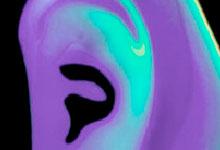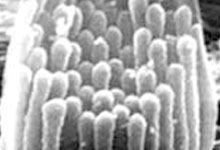

Since its inception, the NOHR Foundation has provided nearly $9.5 million for almost 500 separate research grants. In 2011, we are funding 9 different projects. Ultimately, discoveries about auditory function will lead to strategies to treat, prevent or cure hearing loss, deafness and related disorders.
2010-2011 TWO-YEAR STRIA VASCULARIS PROJECT
The NOHR Foundation is providing one investigation $25,000 in 2011 for the second year of a two-year, $50,000 project concerned with hearing loss whose underlying basis is a disruption of lateral wall homeostasis. This grant is supporting the following:
Investigation to profile gene expression in the lateral cochlear wall in order to clarify the genetics of the Pendred Syndrome (DFNB4 - Enlarged Vestibular Aqueduct Disease Spectrum). Pendred Syndrome is the most common syndromic form of deafness, responsible for at least 10% of hereditary hearing loss in humans. During 2011, 30 relevant genes identified during 2010 are being studied. Also, a patient population will be screened for mutations in these genes. This project has potential application to caring for Pendred Syndrome patients with progressive hearing loss. The goal is prevention of progressive hearing loss in affected persons. (Richard J.H. Smith, M.D., University of Iowa)
ONE-YEAR SEED MONEY GRANTS
- Cochlear implant-design related study relevant to improving speech understanding in noisy listening conditions for wearers of these devices. Cochlear implants are the only medical treatment available to restore partial hearing to a severely-to-profoundly deafened person (Fei Chen, Ph.D., University of Texas at Dallas -- Department of Electrical Engineering)
- Investigation testing a multifacted approach to protecting the cochlea and reducing permanent hearing loss from the widely used cancer drug cisplatin, which can be ototoxic (Michael Anne Gratton, Ph.D., Saint Louis University -- Department of Otolaryngology Head and Neck Surgery)
- Creation of mouse models with different mutated genes to study a �tool� known as the VsEP, an electrical response produced by the brain, to assess vestibular function in genetic diseases. The VsEP provides a measure of both peripheral (ear) and central (brain) function. There are currently few tests to detect vestibular inner ear pathology. (Timothy A. Jones, Ph.D., East Carolina University -- Department of communication Sciences and Disorders)
- Investigation of the role of calcium in transmission of electrical information about sound to the brain by the inner ear's spiral ganglion neurons. The project is relevant to both hearing disorders and such vestibular disorders as Meniere's disease. (Ping Lv, Ph.D. University of California, Davis --Department of Anesthesiology & Pain Medicine/Neuroscience)
- Investigation of genetic factors that confer susceptibility to chronic otitis media with effusion through the immune system's response to infection. The study is relevant to development of new treatments for otitis media and to identification of children at higher risk for long term ear-infection complications like hearing loss and delayed speech (Carole MacArthur, M.D., Oregon Health and Science University -- Oregon Hearing Research Center)
- Project with the goal of developing a mouse model system to study mutations in a gene that cause congenital, prelingual deafness. Findings may have clinical relevance to in early diagnosis, prognosis and genetic counseling. Saima Riazuddin, Ph.D., Cincinnati Children's Hospital Medical Center -- Department of Pediatric Otolaryngology Head & Neck Surgery.
- Development of an experimental �tool� to study and manipulate normal development and function of neuronal circuits in the binaural auditory brainstem of birds. Findings may contribute to development of therapies for individuals deprived of sound early in life. (Jason Tait Sanchez, Ph.D. University of Washington -- Department of Otolaryngology Head and Neck Surgery)
- Genetic study of how a dysfunctional hair cell protein contributes to hearing loss from noise and the progressive hearing loss of presbycusis. (Dwayne Simmons, Ph.D., University of California Los Angeles -- Department of Integrative Biology and Physiology)
Johns Hopkins University
 |
National Institute on Deafness and Other Communication Disorders www.nidcd.nih.gov |
 |
Association for Research in Otolaryngology www.aro.org |
 |
American Academy of Otolaryngology www.entnet.org |
 |
Sophie SoundCheck www.sophiesoundcheck.org |







